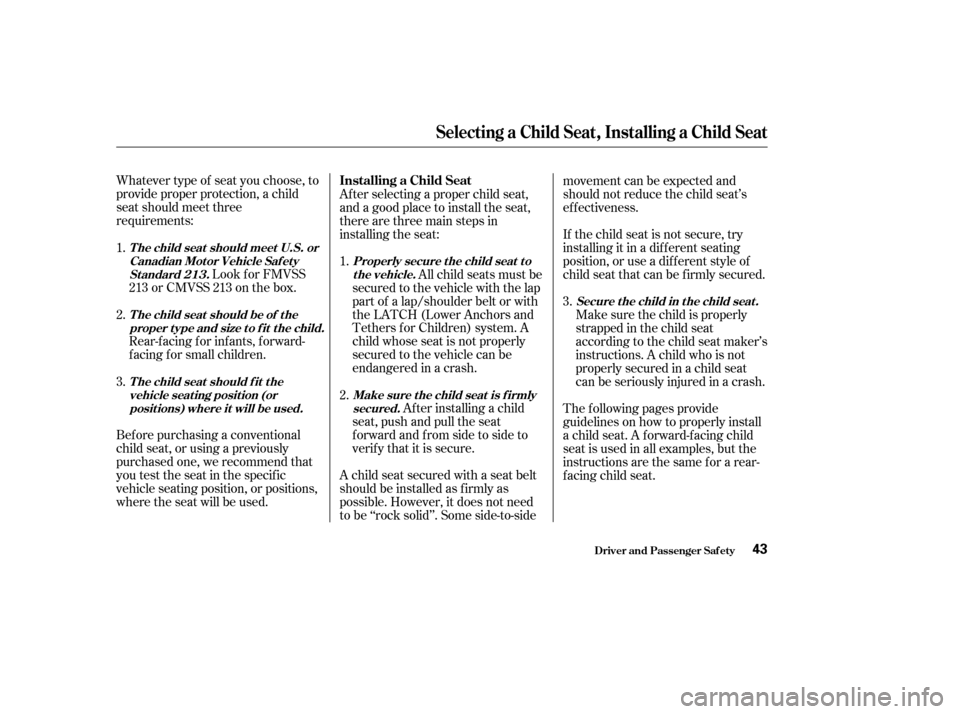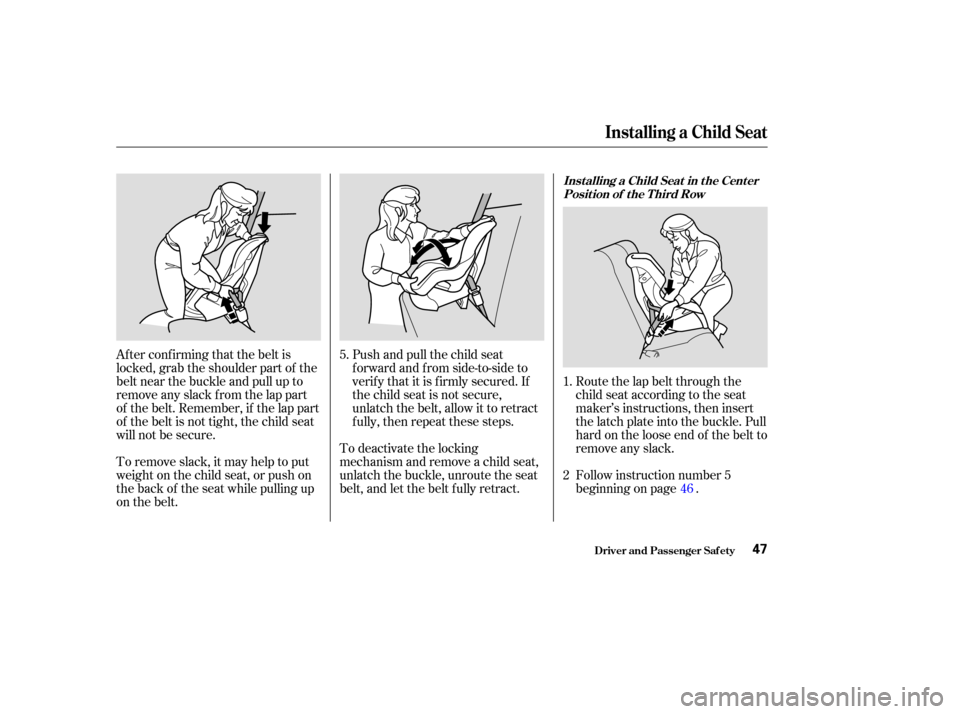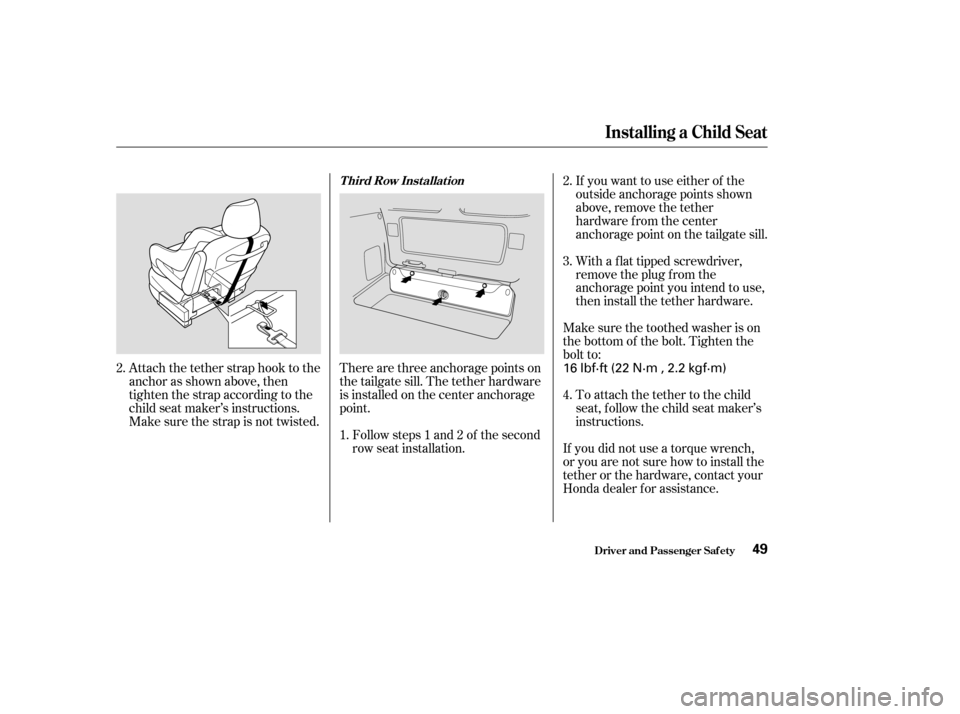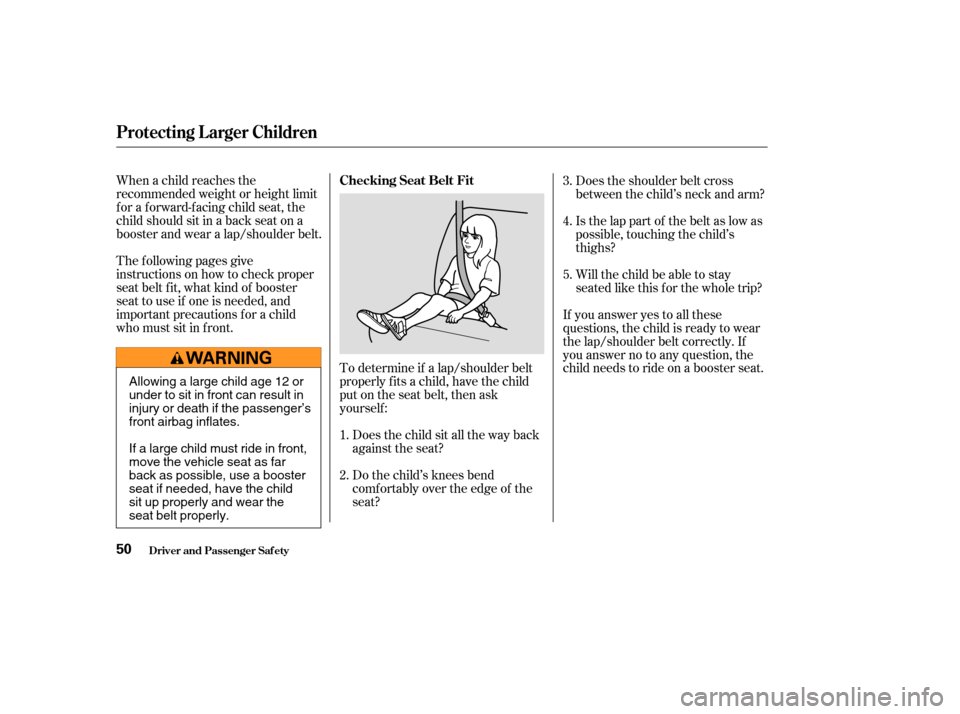Page 46 of 296

Whatever type of seat you choose, to
provide proper protection, a child
seat should meet three
requirements:Look f or FMVSS
213 or CMVSS 213 on the box.
Rear-facing for infants, forward-
f acing f or small children.
Bef ore purchasing a conventional
child seat, or using a previously
purchased one, we recommend that
you test the seat in the specif ic
vehicle seating position, or positions,
where the seat will be used. Af ter selecting a proper child seat,
and a good place to install the seat,
there are three main steps in
installing the seat:
All child seats must be
secured to the vehicle with the lap
part of a lap/shoulder belt or with
the LATCH (Lower Anchors and
Tethers f or Children) system. A
child whose seat is not properly
secured to the vehicle can be
endangered in a crash.
Af ter installing a child
seat, push and pull the seat
f orward and f rom side to side to
verif y that it is secure.
A child seat secured with a seat belt
should be installed as f irmly as
possible. However, it does not need
to be ‘‘rock solid’’. Some side-to-side movement can be expected and
should not reduce the child seat’s
ef f ectiveness.
If the child seat is not secure, try
installing it in a dif f erent seating
position, or use a dif f erent style of
child seat that can be f irmly secured.
The f ollowing pages provide
guidelines on how to properly install
a child seat. A f orward-f acing child
seat is used in all examples, but the
instructions are the same f or a rear-
f acing child seat.
Make sure the child is properly
strappedinthechildseat
according to the child seat maker’s
instructions. A child who is not
properly secured in a child seat
can be seriously injured in a crash.
1.
2.
3.
1.
2.
3.
Selecting a Child Seat, Installing a Child Seat
Driver and Passenger Saf ety
T he child seat should meet U.S. or
Canadian Mot or Vehicle Saf et ySt andard 213.
T he child seat should be of theproper t ype and size t o f it t he child.
T he child seat should f it thevehicle seat ing posit ion (orposit ions) where it will be used. Properly secure t he child seat t o
the vehicle.
Make sure t he child seat is f irmlysecured. Secure the child in the child seat.
Installing a Child Seat
43
Page 47 of 296
Move the seat belt buckle or
tongue away f rom the lower
anchors.
Make sure there are no objects
near the anchors that could
prevent a secure connection
between the child seat and
anchors.Place the child seat on the vehicle
seat, and attach the seat to the
lower anchors according to the
child seat maker’s instructions.
Some LATCH-compatible seats
have a rigid-type connection as
shown above.
Your vehicle is equipped with
LATCH (Lower Anchors and
Tethers f or Children) in the two
second row seats. The lower anchors
are located between the seat-back
and seat bottom, and are to be used
only with a child seat designed f or
use with LATCH.
To install a LATCH-compatible child
seat: Small marks are positioned to
indicate the locations of each anchor
point.
1.
2. 3.
Driver and Passenger Saf ety
Installing a Child Seat
Installing a Child Seat Using
LATCH
44
RIGID TYPE
LOWER
ANCHORS LOWERANCHORMARKS
Page 48 of 296
Other LATCH-compatible seats have
a f lexible-type connection as shown
above.Whatever type you have, f ollow
the child seat maker’s instructions
f or adjusting or tightening the f it. Route the tether strap through the
legs of the head restraint, then
attach the hook to the anchorage
point on the underside of the seat
cushion as shown.Push and pull the child seat
f orward and f rom side-to-side to
verif y that it is secure. Make sure the strap is not twisted,
then tighten the strap according to
the child seat maker’s instructions.
4. 5.6.
7.
Driver and Passenger Saf ety
Installing a Child Seat
45
FLEXIBLE TYPE
Page 49 of 296
When not using the LATCH system,
all child seats must be secured to the
vehicle with the lap part of a lap/
shoulder belt.
In addition, the lap/shoulder belts in
the second row seats, the outer seats
in the third row, and the f ront
passenger seat have a locking
mechanism that must be activated to
secure a child seat.With the child seat in the desired
seating position, route the belt
through the child seat according
to the seat maker’s instructions,
then insert the latch plate into the
buckle.To activate the lockable retractor,
slowly pull the shoulder part of the
belt all the way out until it stops,
then let the belt f eed back into the
retractor.
Af ter the belt has retracted, tug on
it. If the belt is locked, you will not
be able to pull it out. If you can pull
the belt out, it is not locked and
you will need to repeat these steps.
1.
2.
3.
Installing a Child Seat
Driver and Passenger Saf ety
Installing a Child Seat with a L ap/
Shoulder Belt
46
Page 50 of 296

To remove slack, it may help to put
weight on the child seat, or push on
the back of the seat while pulling up
on the belt.Follow instruction number 5
beginning on page . Route the lap belt through the
child seat according to the seat
maker’s instructions, then insert
the latch plate into the buckle. Pull
hard on the loose end of the belt to
remove any slack.
Af ter conf irming that the belt is
locked, grab the shoulder part of the
belt near the buckle and pull up to
remove any slack from the lap part
of the belt. Remember, if the lap part
of the belt is not tight, the child seat
will not be secure.
Push and pull the child seat
f orward and f rom side-to-side to
verif y that it is f irmly secured. If
the child seat is not secure,
unlatch the belt, allow it to retract
f ully, then repeat these steps.
To deactivate the locking
mechanism and remove a child seat,
unlatch the buckle, unroute the seat
belt, and let the belt f ully retract. 5.
46
1.
2
Installing a Child Seat
Driver and Passenger Saf ety
Inst alling a Child Seat in t he Cent er
Position of the T hird Row
47
Page 51 of 296
A child seat with a tether can be
installed in any seating position in
the second or third row.
Since a tether can provide additional
security to the lap/shoulder belt
installation, we recommend using a
tether whenever one is required or
available. (Tethers are required in
Canada.)Each second row bucket seat has a
tether anchorage point on the
underside of the seat cushion. Af ter securing the child seat in the
desired position (see page ),
route the tether strap over the top
of the seat-back and between the
head restraint legs.
1.
46
Installing a Child Seat
Driver and Passenger Saf ety
Installing a Child Seat with a
TetherSecond Row Inst allat ion
48
TETHER ANCHORAGE POINT
Page 52 of 296

Attach the tether strap hook to the
anchor as shown above, then
tighten the strap according to the
child seat maker’s instructions.
Make sure the strap is not twisted.Followsteps1and2of thesecond
row seat installation.
There are three anchorage points on
the tailgate sill. The tether hardware
is installed on the center anchorage
point. If you want to use either of the
outside anchorage points shown
above, remove the tether
hardware f rom the center
anchorage point on the tailgate sill.
With a f lat tipped screwdriver,
remove the plug f rom the
anchorage point you intend to use,
then install the tether hardware.
Make sure the toothed washer is on
the bottom of the bolt. Tighten the
bolt to:
To attach the tether to the child
seat, f ollow the child seat maker’s
instructions.
If you did not use a torque wrench,
or you are not sure how to install the
tether or the hardware, contact your
Honda dealer f or assistance.
2. 2.
1. 3.
4.
Installing a Child Seat
Driver and Passenger Saf ety
T hird Row Inst allat ion
49
16 lbf·ft (22 N·m , 2.2 kgf·m)
Page 53 of 296

When a child reaches the
recommended weight or height limit
for a forward-facing child seat, the
child should sit in a back seat on a
booster and wear a lap/shoulder belt.
The f ollowing pages give
instructions on how to check proper
seat belt f it, what kind of booster
seat to use if one is needed, and
important precautions f or a child
who must sit in f ront.To determine if a lap/shoulder belt
properly f its a child, have the child
put on the seat belt, then ask
yourself :Does the child sit all the way back
against the seat?
Do the child’s knees bend
comf ortably over the edge of the
seat? Does the shoulder belt cross
between the child’s neck and arm?
Is the lap part of the belt as low as
possible, touching the child’s
thighs?
Will the child be able to stay
seated like this f or the whole trip?
If you answer yes to all these
questions, the child is ready to wear
the lap/shoulder belt correctly. If
you answer no to any question, the
child needs to ride on a booster seat.
1.
2. 3.
4.
5.
Protecting L arger Children
Driver and Passenger Saf ety
Checking Seat Belt Fit
50
Allowing a large child age 12 or
under to sit in front can result in
injury or death if the passenger’s
front airbag inflates.
If a large child must ride in front,
move the vehicle seat as far
back as possible, use a booster
seat if needed, have the child
sit up properly and wear the
seat belt properly.